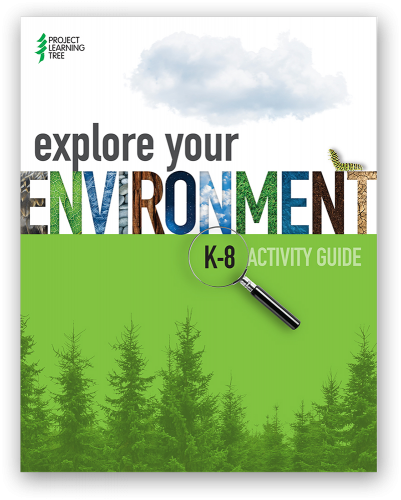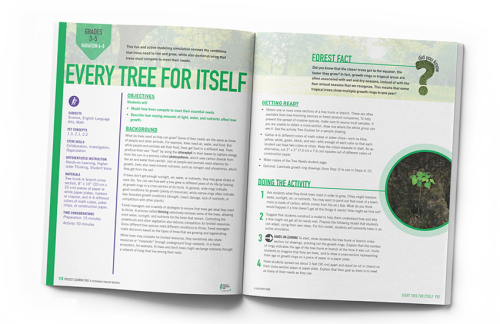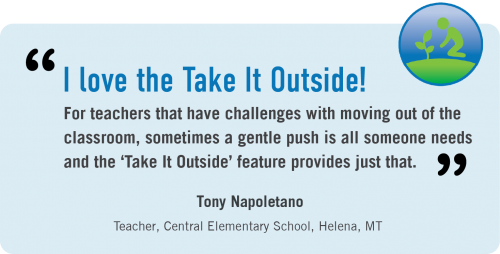April 6, 2021
 Project Learning Tree® (PLT) released a new curriculum guide today to engage kindergarten through grade 8 students in exploring their environment. Fifty field-tested, hands-on activities integrate investigations of nature with science, math, English language arts, and social studies.
Project Learning Tree® (PLT) released a new curriculum guide today to engage kindergarten through grade 8 students in exploring their environment. Fifty field-tested, hands-on activities integrate investigations of nature with science, math, English language arts, and social studies.
Educators can obtain a copy of PLT’s Explore Your Environment: K-8 Activity Guide directly from PLT’s Shop, from Amazon and other places where books are sold, or by attending a local PLT professional development workshop conducted by PLT’s 50-state network of 75 coordinators and 1,000 facilitators across the country.
Project Learning Tree is a long-established, award-winning environmental education program that uses trees and forests as windows on the world to advance environmental literacy, stewardship, and pathways to green careers. This new, cutting-edge resource for educators offers robust, real-world learning experiences for students designed to bolster STEM (science, technology, engineering and math) learning, promote civic engagement, and help young people acquire the skills they’ll need to be creative problem solvers. The activities develop students’ critical thinking skills as they participate in hands-on learning, debate real-life environmental decisions, and engage with their community in action projects.
“The guide is fresh, it’s user-friendly, and it works indoors and outdoors, in classrooms and nonformal settings, in urban, suburban, and rural settings” says Jaclyn Stallard, PLT’s Director of Curriculum. “Educators can easily integrate the activities into their existing curriculum or other programming to actively engage students in learning about both the natural world and the built environment. Every activity in the guide suggests ways to take student learning outside, which has only increased in importance to many parents and educators over the last year due to Covid-19.”
Hands-on classroom studies and outdoor field investigations
“For teachers that have challenges with moving out of the classroom, sometimes a gentle push is all someone needs and the ‘Take It Outside’ feature provides just that,” said Tony Napoletano, a public school teacher at Central Elementary School in Helena, MT, one of more than 40 educators who field-tested the activities with students. “The ‘I Love My Green Job’ highlights are also exciting. They show kids early on what careers they might want to pursue and just how many options there are in the green job field.”
PLT uses experiential learning, inquiry-based investigations, outdoor education, and service learning to help educators make learning relevant and fun for students. In addition, every activity includes career connections to further link learning to real-life experiences.

To ensure that PLT meets the needs of educators, hundreds of professional educators and technical experts help develop, review, field test, and evaluate all of PLT’s curriculum materials. The process includes research, surveys, writing workshops, and reviews with educators and natural resource professionals; revisions based on field testing; and formal assessment of impact on student learning by independent evaluators.
“There are a variety of ways to incorporate the activities into what I am already teaching,” said another pilot tester, Dr. Robin C. McLean, Agriscience teacher and Career and Technical Education at Northern Burlington County Regional Middle School in Columbus, NJ. “The strategies for differentiation and enrichment help to meet the diverse needs of my students and make the experience relevant for them.”
“I like how you list ideas for adapting activities to different age groups,” said Laura Bland, a state park naturalist with Michigan Department of Natural Resources. “This is important to me as I work with a variety of ages.”
PLT is committed to accessibility and this guide was developed through a critical lens of justice and inclusion. PLT’s model of professional development also helps to ensure that instruction and content strategies can be modified to meet the needs of all learners.
Engaging and Easy to Implement
Birds and Bugs. Web of Life. Forest in the City. These are three examples of the 50 activities found in the 432-page guide that is organized by grade level. Each activity provides educators all the information they need to plan, organize, and conduct the learning experience, as well as assessment and enrichment opportunities. Importantly for educators, each activity displays explicit connections to practices and concepts mandated by the Next Generation Science Standards (NGSS), Common Core State Standards (CCSS) for English Language Arts and Mathematics, and College, Career, and Civic Life Framework for Social Studies (C3).

Another hallmark of PLT is professional development that offers educators the opportunity to participate in PLT activities, enhance their teaching skills, and become comfortable teaching outdoors. PLT’s 50-state network trains 15,000 PreK-12 educators every year through 800 workshops held across the country.
An online course option for educators to learn on their own schedule how best to use PLT’s new K-8 Activity Guide specific to their setting will be published later this year (August 2021).
“Exposure to nature has many proven benefits for physical and mental health and learning outdoors can enhance academic achievement,” says Jessica Kaknevicius, Vice President of Education for the Sustainable Forestry Initiative (SFI). PLT is an initiative of SFI.
“Furthermore, engaging students in exploring their environment provides important opportunities for youth to become engaged in real-world issues” she says. “From the earliest grades on up, they see the relevance of their classroom studies and acquire the skills needed for green careers in the 21st-century workplace.”


